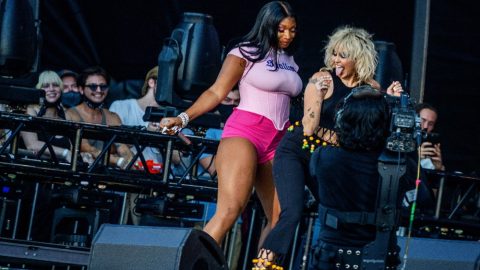
“I think there’s something in the air in Camden that gives you the courage to try things,” extols host (and executive producer) Dua Lipa in the first episode of Camden, an ambitious documentary series that attempts to chart the storied London borough’s impact on music. It presents Camden as a cultural melting pot that sparks game-changing musical hybrids. A scuzzy bacchanal “Balamory” (as Yungblud describes it) and “mecca for misfits” (according to Carl Barât) where rents were cheap enough to allow artists to try on different identities like Mr Benn.
Trying to condense the history of the postcode into four (roughly) hour-long episodes means that Camden is entertaining, but occasionally scattershot and lacking focus. Episode one largely revolves around the rise of local pop colossus Lipa and Coldplay, via indie citadel The Dublin Castle, where Madness led the two-tone ska explosion in 1979 and the Queen of Camden Amy Winehouse could later be found pulling pints.
It’s big on reverential mythos, like the documentary equivalent of a blue plaque, but there’s gold amidst the platitudes. The second instalment, ‘Rebels and Misfits’, hots up thanks to the inclusion of The Libertines and quote-machine Noel Gallagher. The latter, who bagged a flat in Camden in 1993, mocks the clichéd documentary convention of filming an artist foraging through the racks of a record shop by remarking: “There’s a lot of One Direction here!” He also remembers being kicked out of Britpop boozer The Good Mixer for (ahem) “good naturedly ribbing Graham Coxon at the bar”.
Breaking down the barriers between artists and fans, The Libs’ Pete Doherty recalls posting gigs happening in their abode with less than half an hour’s notice – much to the chagrin of Barât, whose washing was hanging in the bathroom. He also shares the story of The Clash guitarist and ’Up the Bracket’ album producer Mick Jones falling asleep twice while recording its title track.

Episode three, ‘Pioneers’, traces how American hip-hop stars including Public Enemy and The Roots relocated to Camden to escape the straitjacket of stateside expectations of what Black artists should be. Then the final furlong zeroes in on partying: Boy George swaps suburbia for Camden’s heady exotica, pioneering DJ Norman Jay sets up free warehouse parties as a reaction to the apartheid of London clubbing, and Sister Bliss discovers house music in Camden warehouses before Faithless play their first gig at local venue the Jazz Café.
Only Amy Winehouse’s first manager Nick Shymansky offers an alternative to the love-in by suggesting that “Camden was a dangerous place for someone like her”. Elsewhere, many of the same points keep getting made. By the time Lipa turns up in Cyberdog to find another way of saying “Camden lets you be whoever you want to be!”, cold-hearted viewers might be tempted to reply: “I want to be someone watching a deeper dive!” At times, seeing Olympic-level interviewees like Gallagher and Boy George hemmed in by the talking head format feels a bit like watching Tom Daley dive into a bathtub.
Still, with Chris Martin noting that Coldplay’s early days revolved around six pubs in the area (“If you could guarantee you’d bring ten people, they’d let you play”), and Little Simz highlighting the importance of free artist development schemes at The Roundhouse, Camden implicitly feels like a love-letter to endangered independent venues. The question is: with Disney+ memorialising it in a documentary, does authentic “non-conformist” Camden risk becoming an ersatz rock ‘n’ roll theme park?
‘Camden’ is streaming now on Disney+
The post ‘Camden’ review: Dua Lipa’s documentary is a love letter to endangered independent venues appeared first on NME.




